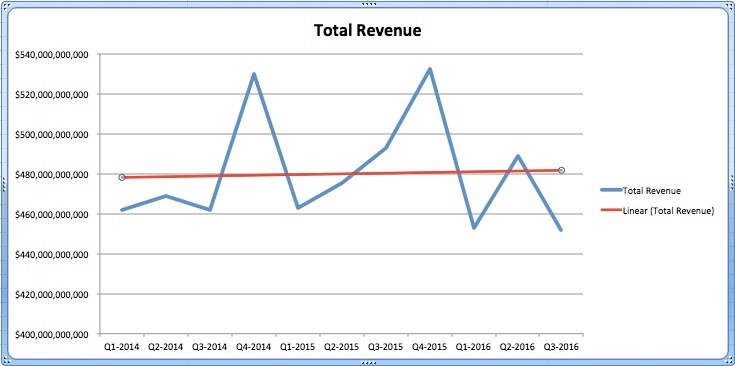We’ve seen a spate of news recently about department stores suffering under poor holiday sales, and subsequently announcing store closings. Calcbench won’t pick on any specific companies here, but thanks to our Data Query Tool, we can illuminate some of the broader trends in retail sales and the physical stores those companies use to move product.
First, our sample population. Sorting by SIC codes, we found 371 filers across a range of retail sectors: general merchandise, apparel, home furnishings, food, and miscellaneous items. Then we looked at a few metrics of revenue, assets, and PP&E (property, plant, and equipment) from first-quarter 2014 through third-quarter 2016.
Let’s start with the revenue numbers. Taken as a whole, revenue for this population is only moping along: from $461.9 billion in first quarter 2014, to $451.8 billion in third quarter 2016. Now, retail sales do fluctuate quite a bit from quarter to quarter; second-quarter 2016 sales, for example, were $488.9 billion. But when you look at the overall trend line, below in red, the upward slope is pretty gentle.

On the other hand, average revenue for these 371 filers looks much better: up 25 percent over those same 11 quarters, and a much more upwardly sloped trend line. (Figure 2, below.)

Why the divergence? From this cursory analysis, we can’t tell. Our first guess is that a few larger retailers are growing at a relatively slower pace, therefore pulling the whole sector down even as many smaller players do OK. We might be wrong, but remember the First Rule of Calcbench: our databases can present large volumes of data quickly and easily, so you can find trends worthy of further exploration. This is one of them.
Property, Plant & Equipment
Things get even more interesting when we look specifically at PP&E. For the whole sector, PP&E dropped from $326.7 billion at the start of 2014 to $315.4 billion by fall 2016. Yes, the numbers zigzagged from quarter to quarter, but the trend is clearly down. (Figure 3.)

That’s not terribly surprising, given consumers’ move away from shopping in physical stores in favor of online; and retailers’ subsequent need either to close stores outright or to sell them to a real estate trust and lease the space back. But again, when you look at average PPE per filer, the trend line shoots up. (Figure 4.)

What does that divergence tell us? Again, we here at Calcbench HQ don’t know—but the purpose of this post is to show how easily Calcbench databases can help you find good questions to ask, and then dive more deeply to find the answers.
For example, if you’re an analyst following specific retailers, you could easily map one company’s numbers to the overall averages we found. Or you could research leasing expenses, to see how much they are rising as overall PP&E is falling. Or you could use our Interactive Disclosure tool to dive into the footnotes of specific companies and see what they are disclosing for PP&E expansion or divestiture.
The possibilities are vast, since our data is, too.